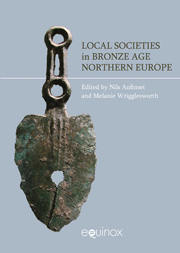Book contents
- Frontmatter
- Contents
- List of figures and tables
- Contributors
- Acknowledgements
- Introduction: local societies, regions and processes of cultural interaction in the Bronze Age
- PART I IDENTITY, GRAND NARRATIVES AND NETWORKS
- 1 Approaching a complex past: entangled collective identities
- 2 Asymmetric twins? Some reflections on coastal and inland societies in the Bothnian area during the Epineolithic and Early Metal Age
- 3 Expressing identity through ritual in the Early Bronze Age
- 4 Large-scale “grand narratives” and small-scale local studies in the Bronze Age discourse: the animal perspective
- 5 Reconsidering a periphery: scenarios of copper production in southern Norway
- 6 On the bronze trail: short-cuts, byways, transformation and displacement
- PART II REGIONS, GLOBALIZATION AND RESISTANCE
- Index
3 - Expressing identity through ritual in the Early Bronze Age
from PART I - IDENTITY, GRAND NARRATIVES AND NETWORKS
- Frontmatter
- Contents
- List of figures and tables
- Contributors
- Acknowledgements
- Introduction: local societies, regions and processes of cultural interaction in the Bronze Age
- PART I IDENTITY, GRAND NARRATIVES AND NETWORKS
- 1 Approaching a complex past: entangled collective identities
- 2 Asymmetric twins? Some reflections on coastal and inland societies in the Bothnian area during the Epineolithic and Early Metal Age
- 3 Expressing identity through ritual in the Early Bronze Age
- 4 Large-scale “grand narratives” and small-scale local studies in the Bronze Age discourse: the animal perspective
- 5 Reconsidering a periphery: scenarios of copper production in southern Norway
- 6 On the bronze trail: short-cuts, byways, transformation and displacement
- PART II REGIONS, GLOBALIZATION AND RESISTANCE
- Index
Summary
Introduction
How do we identify regional or local identity displayed in prehistoric societies? This question is not easily answered, because specific forms of identification do not occur in all contexts, but in different levels and with varying expressions (Bloch 1988: 18; Barth 1996: 77). This means that individuals are involved in interaction at many levels and as members of many different kinds of social groupings (McGuire 1983: 118; Beck 1995: 173; O'Shea 1996: 10ff.; Sørensen 1997: 94; Chapman 2000: 172) – for example, a man from one family, one household, a society, a group of men and a profession. Consequently, identity must be seen through a theoretical pluralism, rather than from only one perspective (Prescott 1995: 28; Meskell 2001: 188). As a result, identity is contextual and related to specific events and interaction (Fowler 2004: 3). This chapter explores human action and context in relation to the understanding of prehistoric identities, and the creation of identity in a local area (the small region of Thy in the northwestern part of Denmark, west of the Limfjord) through material culture from Early Bronze Age burials. This specific context consists of 255 closed burial finds all dated to the Early Bronze Age, primarily from periods II and III.
Ritual action as identity
Since the work of Pierre Bourdieu was implemented in archaeological studies, we have been conscious of action as a central element in the production and reproduction of social structures, and of course the creation of identity (Bourdieu 1977).
- Type
- Chapter
- Information
- Local Societies in Bronze Age Northern Europe , pp. 56 - 70Publisher: Acumen PublishingPrint publication year: 2012



